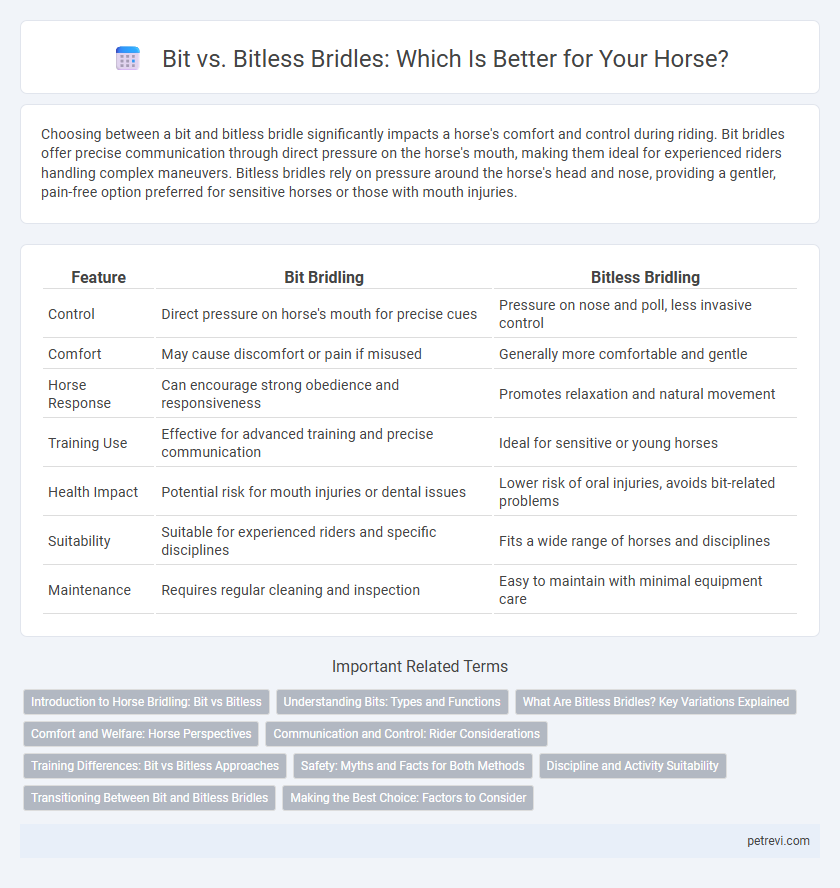Choosing between a bit and bitless bridle significantly impacts a horse's comfort and control during riding. Bit bridles offer precise communication through direct pressure on the horse's mouth, making them ideal for experienced riders handling complex maneuvers. Bitless bridles rely on pressure around the horse's head and nose, providing a gentler, pain-free option preferred for sensitive horses or those with mouth injuries.
Table of Comparison
| Feature | Bit Bridling | Bitless Bridling |
|---|---|---|
| Control | Direct pressure on horse's mouth for precise cues | Pressure on nose and poll, less invasive control |
| Comfort | May cause discomfort or pain if misused | Generally more comfortable and gentle |
| Horse Response | Can encourage strong obedience and responsiveness | Promotes relaxation and natural movement |
| Training Use | Effective for advanced training and precise communication | Ideal for sensitive or young horses |
| Health Impact | Potential risk for mouth injuries or dental issues | Lower risk of oral injuries, avoids bit-related problems |
| Suitability | Suitable for experienced riders and specific disciplines | Fits a wide range of horses and disciplines |
| Maintenance | Requires regular cleaning and inspection | Easy to maintain with minimal equipment care |
Introduction to Horse Bridling: Bit vs Bitless
Horse bridling involves choosing between bit and bitless options to ensure effective communication and comfort. Bit bridles use a metal mouthpiece to control the horse, providing precise cues but may cause discomfort if misused. Bitless bridles rely on pressure around the horse's head, offering a gentler alternative that promotes natural movement and reduces risk of oral injury.
Understanding Bits: Types and Functions
Bits come in various types including snaffle, curb, and pelham, each designed to communicate specific signals to the horse through pressure on the mouth, poll, or chin. Snaffle bits apply direct pressure and are generally milder, ideal for basic control and training, while curb bits use leverage to exert more force and refined cues. Understanding these functions helps riders choose the appropriate bit to enhance communication, control, and comfort during bridling.
What Are Bitless Bridles? Key Variations Explained
Bitless bridles offer a comfortable alternative to traditional bits by applying pressure to the horse's head, face, and nose instead of the mouth, reducing the risk of oral pain or injury. Key variations include side-pull bridles, which exert pressure on the sides of the horse's head, and cross-under bridles that distribute pressure evenly beneath the jaw, enhancing communication without direct mouth contact. These designs prioritize horse comfort and responsiveness, making bitless options increasingly popular in riding disciplines focused on gentle control.
Comfort and Welfare: Horse Perspectives
Bitless bridles enhance horse comfort by eliminating pressure on the sensitive bars and tongue, reducing the risk of oral injuries and stress. Horses often exhibit calmer behavior and improved responsiveness with bitless options, promoting overall welfare and trust. Contemporary studies highlight the welfare benefits of bitless bridling, emphasizing pain-free communication and natural jaw movement.
Communication and Control: Rider Considerations
Bit bridling offers precise communication through direct pressure on the horse's mouth, allowing riders fine control and immediate response, which is ideal for complex maneuvers or disciplines requiring detailed cues. Bitless bridling relies on pressure points on the horse's head and face, promoting a softer, more humane approach that reduces the risk of mouth discomfort, making it suitable for sensitive horses or natural horsemanship practices. Riders must assess their horse's temperament, training level, and specific riding goals to determine the most effective and ethical method for communication and control.
Training Differences: Bit vs Bitless Approaches
Bit training involves direct control through pressure on the horse's mouth, promoting precision in responses but potentially causing discomfort if misused. Bitless training uses pressure points on the horse's head and nose, encouraging communication without oral discomfort, often resulting in a more relaxed and willing demeanor. Understanding these training differences helps riders select the best method for temperament, discipline, and desired control level.
Safety: Myths and Facts for Both Methods
Bit bridling, traditionally used for precise control, carries misconceptions about causing pain, though properly fitted bits ensure horse comfort and effective communication. Bitless bridles, often praised for being gentler, still require correct adjustment to prevent discomfort or lack of control, challenging the myth that they are inherently safer. Safety depends on the rider's skill and the correct fit of either bit or bitless bridle, emphasizing knowledge over assumptions in horse management.
Discipline and Activity Suitability
Bit bridles provide precise control essential for disciplines like dressage and jumping, where clear communication between rider and horse is critical. Bitless bridles are favored in trail riding and natural horsemanship due to their gentler pressure and enhanced comfort for horses sensitive to mouth contact. Choosing between bit and bitless bridles depends on the horse's responsiveness and the specific demands of the riding activity.
Transitioning Between Bit and Bitless Bridles
Transitioning between bit and bitless bridles requires gradual desensitization to ensure the horse's comfort and responsiveness. Horses accustomed to bits may initially resist bitless bridles, so using consistent cues and gentle rein pressure during training sessions promotes smoother adaptation. Monitoring behavioral changes and adjusting training methods can optimize communication and trust in the bridling transition process.
Making the Best Choice: Factors to Consider
Choosing between bit and bitless bridling depends on factors like the horse's sensitivity, behavior, and training level. Bit bridles offer precise control ideal for advanced horses, while bitless options reduce mouth discomfort and improve comfort for sensitive or young horses. Understanding the horse's physical condition and rider's skill ensures the best choice for effective communication and welfare.
Bit vs Bitless for Horse Bridling Infographic

 petrevi.com
petrevi.com